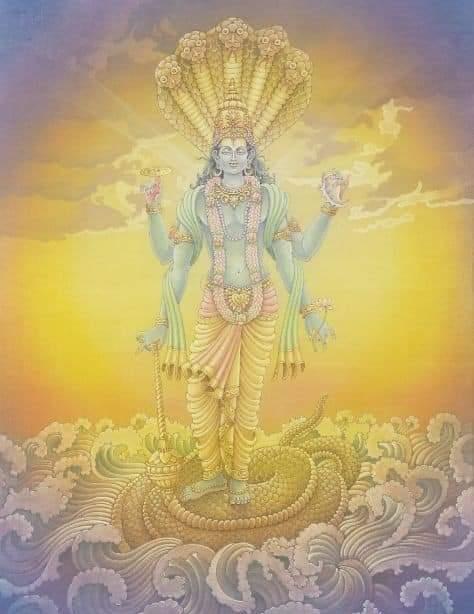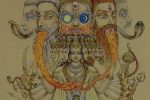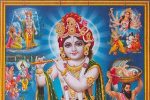Name 97
97. Siddhaḥ सिद्धः
Siddha means a perfected person, the one who has attained the Highest. The one who has realized the Brahman is known as a Siddha. As far as this nāma is concerned, it is used to mean the perfect condition of being established in the Brahman. Brahman alone is perfect. Supremacy of the Brahman is repeatedly emphasized to make a spiritual aspirant understand the attribute of the Brahman. Such repeated affirmations are needed to make a spiritual aspirant to progress from dualism to non-dualism.
Siddhah – The Accomplished
Siddhah is a person of perfect accomplishment. ‘Siddhyati iti Siddhah – One who accomplishes is a Siddhah’.
Sri Adi Sankara gives the interpretation ‘Nithya Nishpanna roopatvaat Siddhah – Ever the perfectly accomplished one’. It is also possible to give the meaning ‘He is present everywhere at all times’.
Sri Parasara Bhattar interprets this as ‘Svaroopenaiva bhaktaanaam siddhatvat siddhah uchyate – He is available to His devotees in His true form.’
९७. ॐ सिद्धाय नमः |
97. OM Siddhāya Namaḥ
Siddhah -One who has achieved all that has to be achieved, as He Himself is the Final Goal for all Or the term can also mean “the most famous”.
One who is available to His is devotees. An interpretation from the Amarakosa gives the definition Siddhyati Iti Siddhah.
Nitya niśpannarūpatvāt siddhaḥ / नित्य निश्पन्नरूपत्वात् सिद्धः – Being eternal and full always, He is Siddhaḥ.
INTERPRETATION GUIDED BY SANT VANI (WORDS OF SAINTS)
Siddhaḥ (also name 819)
Ever accomplished.
He who is eternal and ‘full’ He who is eternally in that state of Pūrṇatva (पूर्णत्व), fullness. He who is ‘complete’ in all respects. He whose state is that of ‘perfection-absolute’(Śaṅkara). He who is ever-existing (in that state of perfect and absolute fullness and bliss)(Parāsara Battar).
A sādhaka is one who seeks to accomplish something; he is the seeker. Sādhana is the means of accomplishing a particular goal. What is to be accomplished is sādhya. What is to be accomplished gives meaning and determines the means or sadhana. When the sādhaka has accomplished the sādhya, employing the sādhana, he is called a siddha. Now in all this, which is Īśvara?
Everyone is Brahman. The seeker is told ‘you are Brahman’, the limitless reality because he does not know that he is Brahman. ‘You are Brahman’ means you are the whole. The whole, the limitless, cannot be separate from you. When you say that you are a sādhak, a seeker, there must be a sādhya, something to be accomplished. There are many seekers who enjoy mysticism and enjoy seeking, hoping that one day they will gain completeness. For them it is one guru after another, one technique after another, one ashram after another. The seeker identity is well entrenched until he/she inquires into siddhatva, with the help of a traditional guru who is already an accomplished Siddha.
If the whole – the sādhya to be accomplished is already accomplished then what is to be done? What is to be gained is exactly what is to be known. The desire for moksha has to convert itself to jignyāsa, the desire to know. You are that whole, which is Brahman.
A lot of us are achievement orientated, because of the many accomplishments in life. This is healthy as it helps us discover our competence in life to be able to handle anything. Yet, when we bring this achiever orientation to the study of Vedanta, the understanding eludes us.
Seemingly, there is nothing to do. And so the achiever identity feels restless and converts much of the teaching into should and should nots, in relentlessly trying to achieve.
There is nothing to accomplish as ‘I’ am already accomplished. We need to learn to relax. In relating to Isvara, we learn how to relax, how to trust the order. That I deserve to be taught, I have the right Guru and I am committed to this knowledge, which is me, I am willing to do what it takes regarding my adhikaritvam (preparedness), are statements which help us relax without the unnecessary build up of anxiety of ‘Will I understand in this lifetime?’
What is to be accomplished is ‘satya jñānam ananta brahma.’ The means of accomplishing is also not separate from Brahman. The siddha-puruṣa, the one who has accomplished, is also not separate from Brahman. Nothing is separate from Brahman. That is what is said in the Gītā as, ‘brahmārpaṇam…brahmaiva tena gantavya brahma-karma samādhinā’ (4.24). So, Brahman is never sādhya but always siddha.
We think that we have to reach Brahman; but it is already reached. It is like saying ‘I have to reach space in two hours.’ But space being all-pervasive, is already siddha. Therefore, you need not reach space. If space is siddha, then the very truth of space, the consciousness, because of which you are conscious of space, that very concept of space, is not separate from consciousness.
That consciousness which is para brahma is also siddha. Īśvara being that para brahma is always siddha. Again, as a jīva, until we know ‘I am Brahman,’ we are still sādhakas. The Lord having no ignorance about Himself, is nitya-niṣpanna-rūpa, is always siddha, one who has accomplished.
A pot that was not there before, is now born. Then it is said to be siddha, having now got its existence from clay. The pot may go. But, from the standpoint of the pot, the clay is always there. Īśvara is the cause of everything and He is manifest in the form of the jagat. The jagat gains its existence from Īśvara. But essentially, there is neither manifestation nor un-manifestation. In His essential nature, He is always satya jñānam ananta brahma, whether the world is manifest or not. This being His nature, He is nitya-niṣpanna-rūpa, always existent. Therefore, He is Siddha, ever accomplished.
The Siddha-Puruṣas attain to that state of fullness through long years of contemplation and great effort, but “He” is forever in that state which is his natural state and therefore he is Siddhaḥ – he is the goal to be contemplated upon, the destination to be reached and the state to be attained – when in the fullness of our beings we offer our all to that Supreme being who needs nothing as he is forever full even though he gives more than he receives, like the ocean, he is ever-full. As this Shānti Mantra states (and paraphrased below)
ॐ पूर्णमद: पूर्णमिदम् पूर्णात् पूर्णमुदस्यते |पूर्णस्य पूर्णमादाय पूर्णमेवावसिष्यते ||ॐ शान्ति शान्ति शान्ति:
Everything in its pristine state is complete/full. It is from the fullness that ‘fullness’ emerges but this does not deplete that, nor this that…
In the Bhagavad-gītā, the Pūrṇāvatāra identifies himself with the great Siddha-Muni Kapila (the propounder of Sāṅkhyayoga)
अश्वत्थ: सर्ववृक्षाणां देवर्षीणां च नारद: |
गन्धर्वाणां चित्ररथ: सिद्धानां कपिलो मुनि: || 26|[1]
aśhvatthaḥ sarva-vṛikṣhāṇāṁ devarṣhīṇāṁ cha nāradaḥ
gandharvāṇāṁ chitrarathaḥ siddhānāṁ kapilo muniḥ
Of trees, I am the Aśhvatthaḥ, and among the Devarṣhīs, know me as Nārada and among the Gandharvas I am Chitrath and among the Siddha-Puruṣas, I am Kapila.
One of the great Pūrṇa-Siddhas, Sri Sadasiva Brahmendra was for close to sixty years of his life in this state of complete Pūrṇatva. He wandered about in a state of absolute bliss and oblivious to the material world around him. In this state of Sacchidānanda, he composed the masterpiece of advaita-vedanta called the Ātma-Vidya-Vilāsa (“Living in the Knowledge of the Ātma/Self”). In the space of 65 short verses he captures that state of fullness known as Siddhaḥ.
Consider Verses 40, 46, 49, 50, 51, 53 and one gets to see what it means to be in that state of perfection and fullness called Siddhaḥ which is the natural state of that Supreme Being – Viṣṇu.
—–Quote
Being the vast reality that remains after dissolving the world entirely (with right knowledge), he eats the handful of food which comes to him by prarabdha karma
Embracing the lady called detachment, engulfed in bliss,he sleeps using his shoulder for a pillow, with the sky as a blanket and with the bare ground as a bed.
The knower of the Self accepts the rows of blue lily flowers in lonely places as his japa mala, the absence of desire towards women as the divine wish yielding creeper and the absence of egoism in the face of humiliation as the medicine for immortality.
The sage rejects nothing, considering it bad; nor does he accept anything, considering it good. Knowing that everything is the creation of avidya, he remains unattached to everything.
He does not think at all of what is past, nor does he care in his mind about the future. He does not even see what is in front of him, for he sees (only) the blissful essence in everything.
The king of Saṃnyāsis rests alone, established in the Self and enjoying inner bliss; he rejects nothing that comes to him and never desires what does not come to him.
—–Unquote
“Without preparation and readiness, any spiritual experience is hardly transformational. And if an experience doesn’t trigger some kind of lasting transformation in you, however subtle, it holds little meaning ultimately. When you continue to walk the path sincerely, diligently, many learnings, lessons, and experiences give you the wisdom to lead your life differently.
Differently so in a manner that it’s more conducive to retaining a state of bliss. Having said that, even if you are enlightened, it doesn’t mean that you won’t experience pain or that you will always find joy in everything that goes on in your life.” – Om Swami



